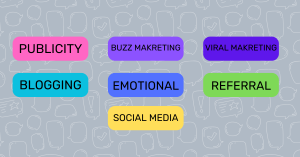Have you ever found yourself raving about an incredible dining experience to your friends, or perhaps recommending a product that you absolutely loved? That’s the magic of word-of-mouth marketing (WOMM) at work. It’s one of the most powerful tools in a marketer’s arsenal, often more impactful than traditional advertising.
In this blog, we’ll explore the uses of word of mouth marketing, its significance, and how you can leverage it for your brand.
What is Word-of-Mouth Marketing?
Word-of-mouth marketing (WOMM) is the process of influencing and encouraging organic discussions about your brand, products, or services. It relies on customers sharing their positive experiences, creating a ripple effect that can significantly boost your brand’s visibility and reputation.

Types of word-of-mouth marketing:
- Publicity: Unplanned media coverage.
- Buzz Marketing: Creating excitement around your product.
- Viral Marketing: Content that spreads quickly online.
- Blogging: Influencers or customers sharing their experiences.
- Emotional Marketing: Tapping into customers’ emotions.
- Referral Marketing: Encouraging recommendations through incentives.
- Social Media Marketing: Leveraging social platforms for engagement.
Why is Word-of-Mouth Marketing Important?
Word-of-mouth marketing (WOMM) leverages the trust and credibility of personal recommendations. This not only leads to higher conversion rates but also encourages long-term customer loyalty. Additionally, word of mouth marketing relies on exceptional service and quality rather than hefty marketing budgets. A single positive review can trigger a cascade of new customers. Here is why WOMM is necessary for a business’s success.
Trust and credibility:
Studies show that 92% of consumers trust recommendations from friends and family more than any other form of advertising. This trust translates into higher conversion rates and customer loyalty.
Cost-effectiveness:
Word of mouth is incredibly cost-effective. It doesn’t require large budgets, just exceptional service and a commitment to quality. Merren’s real-time data analysis provides immediate insights. In this manner, CX teams can quickly act on feedback and create positive customer experiences.
Exponential reach:
The ripple effect of word of mouth marketing has a larger impact. A single positive review can influence countless others, creating a chain reaction of new customers.
3 Key Components of a Successful Word-of-Mouth Marketing Strategy
1. Customer experience:
Exceeding customer expectations can retain previous customers. Example, Trader Joe’s, went above and beyond by delivering groceries during a snowstorm. Simple gestures like personalized thank-you notes or exceptional service can turn customers into brand advocates.
2. Quality products/services:
Quality is non-negotiable. Ensure your products and services are top-notch. Brands like Apple and Spotify have built their reputations on consistently delivering high-quality experiences.
3. Engagement and community building:
Building a loyal customer base is vital. Engage with your customers on social media, respond to feedback, and create a sense of community. Host events or online forums where customers can share their experiences and connect with each other.

How to Encourage Word-of-Mouth Marketing?
An effective word-of-mouth marketing (WOMM) will create an exceptional experience and get customers to naturally talk about your brand. Here’s how you can achieve that:
1. Create exceptional customer experiences
Consistently deliver high-quality products and services that meet or exceed customer expectations. When customers have positive experiences, they are more likely to share them. Personalizing interactions and tailor product recommendations that makes customers feel valued and remembered. Learn about how people feel at every touchpoint. Merren makes it easy by automating touchpoint surveys via WhatsApp and chatbots.
2. Encourage user-generated content (UGC)
Hosting social media contests and giveaways is an effective way to encourage users to share their brand-related experiences.Use branded hashtags to track user participation and amplify reach. Feature customer stories, testimonials, and reviews on your website. Showing real experiences can encourage new visitors into your brand.
3. Using referral programs for word-of-mouth marketing
Referral programs can encourage word-of-mouth marketing. By offering incentives such as discounts, gift cards, or exclusive products, you encourage satisfied customers to actively promote your brand. This increases your customer base since the recommendations come from reliable sources. When customers become brand ambassadors, they voluntarily refer to your company with a desire to earn rewards. A well-structured referral program can boost your brand’s visibility and reputation organically.
4. Leverage social media
Actively engage with your audience by responding to comments, questions, and reviews. Encourage ongoing interaction with your brand. Creating shareable content, such as informative blog posts, reels, memes and visually appealing images. Additionally, collaborating with influencers who align with your brand values can further extend your reach. Their loyal following allows for authentic promotion of your products to a broader audience.
5. Provide outstanding customer service
Quickly address customer inquiries and resolve any issues. Excellent customer service leaves a positive impression and encourages customers to share their good experiences.
6. Follow up after purchases
Reach out to customers after their purchase to ensure they are satisfied. This shows you care about their experience and can prompt positive reviews and word-of-mouth referrals.
How to Handle Negative Word-of-Mouth?
Negative word-of-mouth can be challenging. However, it presents an opportunity to improve your brand’s reputation and customer relationships.
1. Monitor and respond promptly
Implement tools to monitor mentions of your brand on social media, review sites, and forums. Tools like Google Alerts, Hootsuite, and Brandwatch can help you track customer conversations. Respond promptly to show that you value customer concerns and you want to resolve issues immediately. A quick response can prevent the situation from escalating.
2. Address the issue professionally
Acknowledge the customer’s concern. A genuine apology can diffuse a tense situation. Assure them that you take their feedback seriously.
After this, offer a clear and practical solution to the problem. Whether it’s a refund, replacement, or any other form of compensation. Make sure the customer feels that their issue is being addressed effectively.
3. Take the conversation offline
If the discussion becomes too detailed or contentious, suggest moving the conversation to a private channel such as emails, phone calls or direct messaging. This allows for more in-depth communication without airing the issue publicly.
After resolving the issue, follow up with the customer to ensure they are satisfied with the outcome. This extra step shows that you genuinely care about their experience.
4. Learn and improve
Treat negative feedback as valuable data. Analyze recurring complaints to identify common issues that need correction. Use the insights from negative feedback to make necessary improvements. Whether it’s refining your product or enhancing customer service, show that you are committed to continuous improvement.
Let customers know about the changes you’ve made in response to their feedback. This can turn a negative experience into a positive one and demonstrate your commitment to customer satisfaction.
5. Encourage positive word of mouth
Positive reviews and testimonials can help balance out negative feedback. Encourage satisfied customers to leave reviews and share their positive experiences on social media and review sites. This not only builds trust but also provides a counter-narrative to any negative word of mouth.
6. Encourage a customer-centric culture
Train your customer service team to handle negative feedback. Empower them with the tools and authority they need to resolve issues effectively. Always approach negative feedback with empathy. Understanding and addressing the emotional aspect of a customer’s complaint can leave a positive impression. Being transparent about your business practices can mitigate the impact of negative WOMM.
Measuring the Impact of Word-of-Mouth Marketing
While word of mouth marketing can sometimes seem intangible, there are several concrete methods and metrics to measure its success.
1. Net Promoter Score (NPS)
What is NPS?
The Net Promoter Score (NPS) is a popular metric used to measure customer loyalty and satisfaction. It is based on a single question: “How likely are you to recommend our brand to a friend or colleague?” Customers respond on a scale of 0 to 10, where:
- 9-10 are Promoters: Loyal enthusiasts who will keep buying and refer others.
- 7-8 are Passives: Satisfied but unenthusiastic customers. They can get swayed by competitive offerings.
- 0-6 are Detractors: Unhappy customers who can damage your brand through negative feedback.
Calculating NPS:
NPS formula subtracts the percentage of detractors from the percentage of promoters. The score can range from -100 to 100. An NPS above 0 is generally considered good, above 50 is excellent, and above 70 is world-class.
Using NPS:
Regularly measure your NPS to track changes in customer sentiment. Merren’s AI-powered survey builder can help you create and distribute NPS surveys easily.
2. Customer feedback and reviews
Monitor online reviews: Track reviews on platforms such as Yelp, Google, and Trustpilot. These reviews are often used by potential customers to make purchasing decisions.
Encourage reviews: Prompt satisfied customers to share product reviews. This can be done through follow-up emails, post-purchase prompts, or incentives such as discounts on future purchases.
Analyze responses: Use sentiment analysis tools to gauge the overall tone of customer feedback. Look for recurring themes or issues that can provide insights into areas for improvement.
Respond to reviews: Thank customers for their positive feedback and address any concerns raised in negative reviews.
3. Social media metrics
Track engagement metrics likes, shares, comments, and mentions on social media platforms. High levels of engagement means that your content is resonating with the audience across networks. Monitor how often your brand is mentioned or tagged in social media posts. Tools like Hootsuite, Mention, or Brandwatch can help track these mentions and analyze the sentiment.
Analyze viral content and replicate these elements in future campaigns. If you use branded hashtags, track their usage and reach. This can measure the extent of user-generated content.
4. Referral program metrics
Referral rate: Track the number of new customers acquired through referrals. This metric shows how effective your referral program is at driving new business.
Conversion rate: Measure the percentage of referred customers who make a purchase. A high conversion rate indicates that referred leads are high-quality and likely to become loyal customers.
Customer Lifetime Value (CLV): Calculate the lifetime value of referred customers compared to non-referred customers. Referred customers often have a higher CLV.
Incentive redemption: Monitor how often referral incentives are redeemed. This can provide insights into the attractiveness of your referral rewards and whether adjustments are needed.
5. Sales and revenue impact
Track the overall growth in sales and revenue. Compare periods before and after implementing word of mouth marketing strategies to gauge their impact.
Customer Acquisition Cost (CAC): Calculate the cost of acquiring new customers through word of mouth compared to other marketing channels. WOMM typically has a lower CAC, making it a cost-effective strategy.
Measure the rate at which customers make repeat purchases. A high repeat purchase rate indicates strong customer loyalty driven by positive WOMM. Analyze changes in your market share. An increase can be a strong indicator of effective WOMM (more customers choose your brand over competitors).
6. Surveys and feedback forms
Conduct regular surveys to measure overall customer satisfaction. Include questions about how customers heard about your brand and their likelihood to recommend it to others.
Send surveys after a purchase to gather immediate feedback on the customer’s experience. This can provide insights into areas of improvement and help you address issues promptly.
7. Event feedback:
Encourage participants and guests to talk about the event online. It can give you a virtual footfall on your brand website. Collect feedback from attendees and learn about their experiences overall.

Case Studies of Successful Word-of-Mouth Marketing
To illustrate the power of word-of-mouth marketing, let’s explore some fresh and impactful examples from various industries:
Automotive: Tesla
Tesla’s Referral Program:
Tesla has mastered the art of leveraging word-of-mouth marketing through its highly successful referral program. Tesla rewards customers for bringing in new buyers by offering incentives. This includes supercharging credits, exclusive event invitations, and even chances to win a Tesla Roadster. This program has not only driven significant sales but also fostered a strong sense of community among Tesla owners. The excitement of owning and promoting a Tesla has turned many customers into passionate brand advocates.
Banking: American Express
American Express’ “Member-Get-Member” Program:
American Express has effectively utilized word-of-mouth marketing through its “Member-Get-Member” referral program. Existing cardholders are encouraged to refer friends and family members by offering rewards such as bonus points, statement credits, or gift cards. This program taps into the trust and credibility of personal recommendations for high-quality referrals and increased customer acquisition. The success of this program lies in its ability to incentivize both the referrer and the referee that boosts word-of-mouth endorsements.
FMCG: Coca-Cola
Coca-Cola’s “Share a Coke” Campaign:
The “Share a Coke” campaign by Coca-Cola is a stellar example of how personalized marketing can generate massive buzz and word-of-mouth promotion. Coca-Cola replaced its iconic logo on bottles with common names. They encouraged customers to find bottles with their names or the names of friends and family. This simple yet brilliant idea sparked a wave of social media sharing. Many people posted photos of their personalized cola bottles. The campaign created a sense of personal connection with the brand and a significant increase in sales and social media engagement.
IT: Slack
Slack’s Organic Growth through word of mouth marketing:
Slack’s phenomenal growth can largely be attributed to word-of-mouth marketing. By offering an exceptional product that addresses real business communication challenges, Slack has earned widespread acclaim from users. The platform’s ease of use, integrations with other tools, and ability to improve team collaboration have made it a favorite among businesses. Users naturally recommend Slack to their colleagues and professional networks, driving exponential growth without the need for heavy advertising. Slack’s success story highlights the power of delivering a superior product that meets customer needs and encourages organic word-of-mouth promotion.
Retail: Trader Joe’s
Trader Joe’s Exceptional Customer Experience:
Trader Joe’s is renowned for its unique approach to customer service and product offerings. This notable instance generated a significant verbal buzz. A Trader Joe’s store in Pennsylvania delivered groceries to an elderly customer during a snowstorm, despite not typically offering delivery services. This act of kindness was highlighted in news stories, showcasing the brand’s commitment to exceptional customer service. Such positive experiences have helped Trader Joe’s build a loyal customer base via WOM marketing.
Technology: Apple
Apple’s Cult-Like Following:
Apple’s ability to generate word-of-mouth marketing is legendary. The brand’s focus on innovative design, user experience, and high-quality products has cultivated a cult-like customer base. Apple’s launch events, where new products are unveiled, generate significant media coverage and social media chatter. Loyal customers often camp outside stores to be the first to purchase new releases, further fueling the buzz. The ability to generate excitement around Apple products have resulted in a powerful word-of-mouth marketing machine.
Beauty: Glossier
Glossier’s Community-Driven Marketing:
Glossier, a beauty brand, has successfully leveraged its community of customers to drive WOM marketing. The brand actively engages and encourages users to share their beauty routines and product reviews. Involving customers in product development and marketing has created a sense of ownership and loyalty. The brand’s referral program offers discounts for referrals, further incentivizing customers to spread the word. This community-driven strategy has helped Glossier achieve rapid growth and a strong brand presence.
Conclusion
Word-of-mouth marketing is a powerful and cost-effective strategy that can drive significant business growth. By focusing on customer experience, quality, engagement, and leveraging social media and influencers, you can create a positive buzz around your brand. Remember to measure your efforts and address challenges promptly to maintain a strong reputation.
Ready to harness the power of word of mouth marketing? Start by implementing these strategies today and watch your business thrive.

